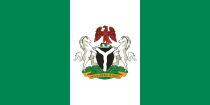Flag of Nigeria
 | |
| Use | National flag |
|---|---|
| Proportion | 1:2 |
| Adopted | 1 October 1960 |
| Design | A vertical bicolour triband of green, white and green. |
| Designed by | Michael Taiwo Akinkunmi |
 | |
| Use | State flag |
| Proportion | 1:2 |
| Design | A vertical bicolour triband of a green, white and green; charged with the coat of arms in the centre. |
 | |
| Use | Civil ensign |
| Proportion | 1:2 |
| Design | A red field with the national flag, in the canton |
 | |
| Use | State ensign |
| Proportion | 1:2 |
| Design | A blue field with the national flag, in the canton |
 | |
| Use | Naval ensign |
| Proportion | 1:2 |
| Design | A white field with the national flag in the canton, with the Naval seal in the fly. |
 | |
| Use | Air force ensign |
| Proportion | 1:2 |
| Design | A sky-blue field with the national flag in the canton, with the air force roundel in the fly. |

The flag of Nigeria was designed by Michael Taiwo Akinkunmi and was officially adopted to represent Nigeria at midnight on 1 October 1960, the day the country gained independence. The flag was chosen as part of a nationwide open contest held by the government, with Akinkunmi's design being selected as the winner of a field of over three thousand entries. The flag is a vertical bicolour green-white-green design, with green representing agriculture and white representing peace and unity.
The flag was raised for the first time in a ceremony by Lieutenant David Ejoor of the Army Guard.
History and design
[edit]In preparation for the independence of Nigeria from the British Empire, a national planning committee was established which set a competition to select a national flag in 1958.[1] In 1959, out of almost 3,000 entries, Michael Taiwo Akinkunmi won the competition with an equal green-white-green with a red quarter sun on the white stripe was chosen.[1] After acceptance, the committee removed the red quarter sun.[2] The accepted flag now consists of a vertical bicolour green-white-green; the green stands for agriculture and the white stands for unity and peace.[1][3] On 1 October 1960, the modern-day flag became the first official flag of an independent Nigeria and was raised for the first time in a ceremony by Lieutenant David Ejoor.[1][2][4]
-
Flag of the Protectorate of Nigeria (1914–1960)
-
Akinkunmi's original design
-
Final design
Historical and variant flags
[edit]In the late 17th century, present-day Nigeria was made up of diverse ethnic groups without national flags[1] In 1914, after the amalgamation of the Southern Nigeria Protectorate and Northern Nigeria Protectorate, Lord Lugard chose a British blue ensign with a green hexagram described as the Zionist-like Star of David surrounding the royal crown with the white word "Nigeria" under it on a red disc as the flag of the Nigerian Protectorate.[1]
The standard of the President of Nigeria from 1960 had a red field with a large green shield and fimbriated white in the centre. It also features a black shield with a wavy-edged "Y"—representing the confluence of the Niger and Benue Rivers. There are three black scrolls containing the legend "President", "Federal Republic", "of Nigeria" placed on each scroll respectively in gold letters.[5] This was replaced with the Nigerian coat of arm placed on the white stripe of the Nigerian flag; this also serves as the state flag.[6]
Colours
[edit]| Green | White | |
|---|---|---|
| RGB | 0/128/0 | 255/255/255 |
| Hexadecimal | #008751 | #FFFFFF |
See also
[edit]References
[edit]- ^ a b c d e f Smith, Whitney (13 November 2018). "Flag of Nigeria". Encyclopedia Britannica. Encyclopædia Britannica, Inc. Retrieved 5 November 2023.
- ^ a b Simwa, Adrianna (18 December 2017). "What the green in the Nigerian flag represents?". Legit.ng. Retrieved 5 November 2023.
- ^ Firth, Raymond (1973). Symbols (Routledge Revivals): Public and Private. Taylor & Francis. p. 351. ISBN 9781136505577.
- ^ Omoigui, Nowa. "Barracks: The History Behind Those Names (Part 5b)". Gamji. Retrieved 5 November 2023.
- ^ Barraclough, E. M. C.; Crampton, William (1981). Flags of the World. London and New York: Frederick Warne & Co. p. 153. ISBN 978-0-7232-2797-7.
- ^ Crampton, William (1990). The Complete Guide to Flags. New York: Gallery Books. p. 136. ISBN 978-0862724665.



